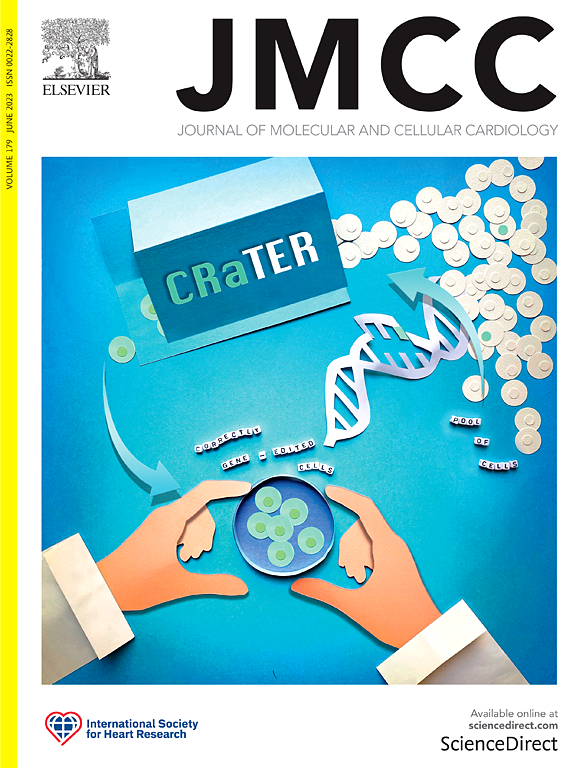在较硬的微环境中,血管蛋白单倍不足会损害整合素介导的肋柱重塑。
IF 4.9
2区 医学
Q1 CARDIAC & CARDIOVASCULAR SYSTEMS
引用次数: 0
摘要
血管蛋白(VCL)是一种关键的接合蛋白,位于承受力的鞘膜复合体中,它将肌节机械地连接到鞘膜上。当施加外部压力时,杂合子移码基因变异可能导致心肌病,但支持VCL单倍功能不全的机械敏感途径仍然难以捉摸。在这里,我们发现在细胞外基质硬化的反应中,VCL的杂合缺失破坏了力介导的肋柱蛋白募集,从而损害了心肌细胞的收缩性和肌节组织。对携带VCL c.659dupA或VCL c.74del7杂合型VCL移码变体的人多能干细胞- cms的分析表明,这些VCL突变型hscs - cms在硬化基质上表现出更高的收缩应变能、形态失调和肌瘤紊乱。在血管素变异的心肌细胞中,肌动蛋白2、帕罗西林、黏附激酶和α-肌动蛋白的机械敏感性募集明显减少。尽管硬底物上整合素β1和皮质肌动蛋白的表达不佳,但刚性底物上整合素β1和皮质肌动蛋白的表达升高可能会挽救硬底物上的力传递,这种作用通过连接整合素受体和阻断机械感觉在WT cm中重现。综上所述,这些数据支持VCL的杂合缺失通过损害黏附介导的从肋柱到细胞骨架的力传递而导致不利的心肌细胞重塑。(191字)。本文章由计算机程序翻译,如有差异,请以英文原文为准。

Vinculin haploinsufficiency impairs integrin-mediated costamere remodeling on stiffer microenvironments
Vinculin (VCL) is a key adapter protein located in force-bearing costamere complexes, which mechanically couples the sarcomere to the ECM. Heterozygous vinculin frameshift genetic variants can contribute to cardiomyopathy when external stress is applied, but the mechanosensitive pathways underpinning VCL haploinsufficiency remain elusive. Here, we show that in response to extracellular matrix stiffening, heterozygous loss of VCL disrupts force-mediated costamere protein recruitment, thereby impairing cardiomyocyte contractility and sarcomere organization. Analyses of human pluripotent stem cell-derived cardiomyocytes (hPSC-CMs) harboring either VCL c.659dupA or VCL c.74del7 heterozygous VCL frameshift variants revealed that these VCL mutant hPSC-CMs exhibited heightened contractile strain energy, morphological maladaptation, and sarcomere disarray on stiffened matrix. Mechanosensitive recruitment of costameric talin 2, paxillin, focal adhesion kinase, and α-actinin was significantly reduced in vinculin variant cardiomyocytes. Despite poorly formed costamere complexes and sarcomeres, elevated expression of integrin β1 and cortical actin on stiff substrates may rescue force transmission on stiff substrates, an effect that is recapitulated in WT CMs by ligating integrin receptors and blocking mechanosensation. Together, these data support that heterozygous loss of VCL contributes to adverse cardiomyocyte remodeling by impairing adhesion-mediated force transmission from the costamere to the cytoskeleton. (191 words).
求助全文
通过发布文献求助,成功后即可免费获取论文全文。
去求助
来源期刊
CiteScore
10.70
自引率
0.00%
发文量
171
审稿时长
42 days
期刊介绍:
The Journal of Molecular and Cellular Cardiology publishes work advancing knowledge of the mechanisms responsible for both normal and diseased cardiovascular function. To this end papers are published in all relevant areas. These include (but are not limited to): structural biology; genetics; proteomics; morphology; stem cells; molecular biology; metabolism; biophysics; bioengineering; computational modeling and systems analysis; electrophysiology; pharmacology and physiology. Papers are encouraged with both basic and translational approaches. The journal is directed not only to basic scientists but also to clinical cardiologists who wish to follow the rapidly advancing frontiers of basic knowledge of the heart and circulation.

 求助内容:
求助内容: 应助结果提醒方式:
应助结果提醒方式:


